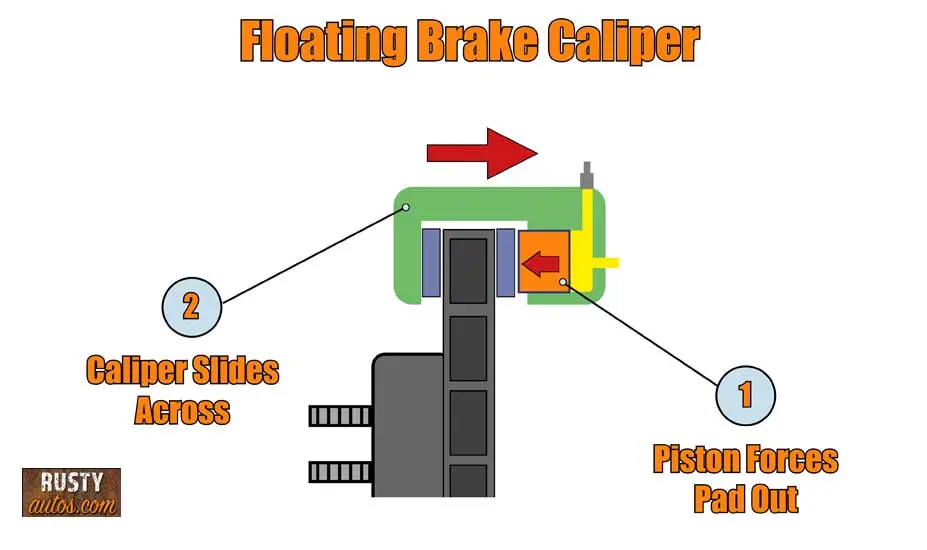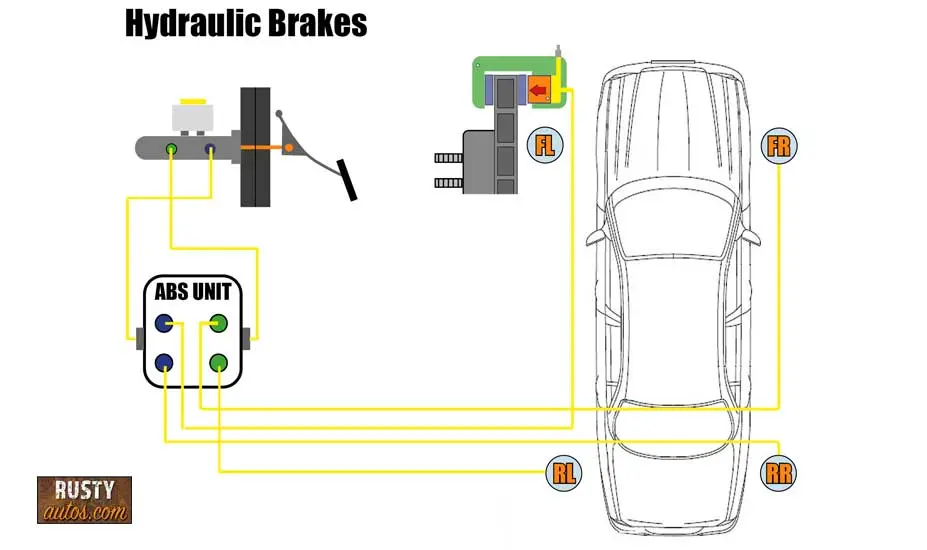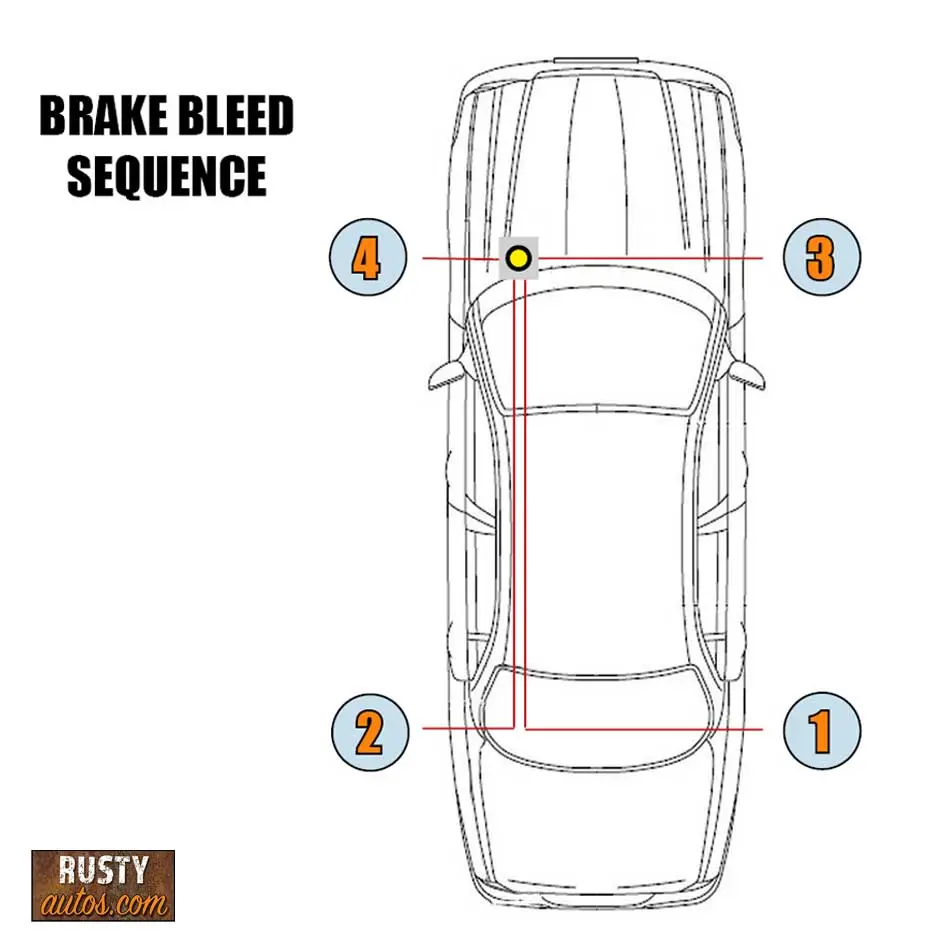Sticking brakes are a real pain, besides being dangerous, they are hard on brakes, engine, and your gas mileage. I’m a mechanic for over twenty, Sticking or dragging brakes are common, and most are a simple fix.
Old brake hoses are prone to disintegration. Rubber debris acts like a valve, trapping brake fluid inside the cylinder, in turn causing the caliper to stick. Replacing all Flexi hoses, brake fluid, and bleeding brakes will fix the problem.
In this post, you’ll learn why a faulty brake hose can cause a sticking caliper and what you can do to fix it.
How Brake Caliper Works
Brake calipers are either fixed or floating, floating is the more common type. A brake caliper as you know utilizes a brake fluid reservoir and hydraulic pressure to displace the caliper piston. The piston in turn forces brakes pads against a spinning rotor causing the wheel to slow and stop.

Releasing the brake pedal allows the displacing brake fluid to return to the brake fluid reservoir which in turn allows the piston and pads to move back into the caliper.

Sticking or dragging calipers are common problems and happen for a number of reasons, such as:
- Seized slide pins
- Seized piston
- Disintegrated brake hose
Seized slide pins and seized caliper pistons are the most common causes of the stuck caliper.

Disintegrated Brake Hose
A solid line between chassis and suspension would simply crimp and break as the chassis bounces around on the suspension.
Brake hoses need to be flexible, they are the fluid coupling between the static chassis where the solid lines and reservoir lives and the dynamic suspension components which is of course where the caliper lives.
The solution is the humble flexible brake hose also known as the flexi hose. These guys work incredibly hard. They come under tremendous internal brake pressure, are constantly being flexed as the chassis rocks, rolls, and bounces. Don’t forget the heat from the rotor, road salts, oil spray, extreme cold.
That said, flexi hoses are twin-walled and you can expect your brake hoses to last ten-plus years easy, these guys are built tough. Problem is, when they begin to fail, they often don’t offer any signs.
Common symptoms of faulty Flexi hose include:
- A sticking caliper is as you know a symptom
- Fading brake pedal under heavy braking
- Car pulling under braking
How does the flexi hose fail?
The hoses commonly fail in a few ways.
- External wall weakens
- Internal wall splits – symptoms may include fading brake pedal
- Internal wall disintegrates – symptoms
External wall weakens – It is natural as you can imagine for the rubber flex hoses to expand as hydraulic pressure is applied. The twin walls offer security in case of a tear or rupture but they also serve to prevent expanding hoses.
Damage or weakness in the outer wall may allow the hose to bulge under braking which will cause brake fade, a condition where the pedal travels to the floor and brake force at the wheel is reduced.
Internal wall split – A common symptom is as per external wall damage, noticeable brake fade, it may also include a fluid leak at the fittings.
Internal wall disintegration – Strips of internal wall rubber peel away and float in the current of brake fluid. The rubber strips allow fluid into the caliper, but as the fluid leaves, the tethered strips block its exit trapping the fluid and causing the caliper to stick.
Brake caliper can drag and smoke for other reasons, which you can check out here.
Inspecting The Flexi Hose
Brake hoses should be inspected regularly. Even young vehicles should be inspected, debris can strike the hoses and damage them, however, the most common failure is old age.
Check the hoses, looking for the following:
- Heavy corrosion around the couplings
- Brake fluid leak or sweat
- Cracking
- Bulging
- Perished rubber
While inspecting have a helper apply brake pedal pressure and check for bulging hoses under pressure.
Replacing Brake Hose

If you find one perished Flexi hose, go ahead and replace them all. Replacing the hoses will mean opening the sealed brake system. Once the system has been opened, the air gets in and must be purged out, it’s known as bleeding the brakes.
A brake bleeding kit isn’t essential but it does make life easier, you can check out all the tools I recommend on the brake tools page here.
I’m sure you are familiar with the process, if not check out this article, “Bleed all brakes when changing caliper”. Replace one flex hose at a time. You’ll need a container to catch the old fluid, some old rags, and some open-ended wrenches.
Begin by separating the fixed brake from the Flexi hose at the chassis. Hold the flex fitting with an open-ended wrench and open the fixed-line fitting anti-clockwise. You may need to clean the fitting using a wire brush first.
The flex hose is commonly fastened to the chassis using a sliding clamp. To remove the clamp, use a flat screwdriver to pry it sideways. Use a wire brush to clean the flexi hose-fitting threads at the caliper. This prevents grit from entering the caliper through the open fitting.
With the flexi hose now free at the chassis, use an open-ended wrench to loosen (turn anti-clockwise) the flexi hose fitting at the caliper. Fit the new hose in reverse order, remembering to refit the chassis side clamp. Repeat this process at all four wheels.
Now you’ll need to bleed the brake system to purge trapped air. You can check out that process here “Brakes won’t bleed”.
To avoid brake system issues, change out brake fluid every three years. Brake fluid absorbs moisture and that causes two problems, corrosion inside the system and brake fade.

Metal components like steel brake lines and caliper pistons will corrode when exposed to moisture, in addition, corrosion inside the system will move around and damage seals.
More serious than corrosion is poor brake performance. Moisture in the fluid turns to steam under heavy use. Steam is compressible and so the brake pedal may feel soft and ineffective under heavy braking.
You may find the brake resources page useful, it’s a fluff-free guide to DIY brake repairs.


- About the Author
- Latest Posts
John Cunningham is an Automotive Technician and writer on Rustyautos.com. He’s been a mechanic for over twenty-five years and has worked for GM, Volvo, Volkswagen, Land Rover, and Jaguar dealerships.
John uses his know-how and experience to write fluff-free articles that help fellow gearheads with all aspects of vehicle ownership, including maintenance, repair, and troubleshooting.

